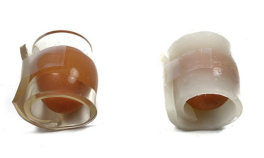Can Biodegradable Materials Replace Plastic as Protective Food Packaging?

Summary
Many foods, such as fresh fruits, vegetables, or eggs, are packaged in plastic to protect them from damage during handling and transport. But is plastic the best choice? What if a more sustainable and biodegradable material could replace it? Researchers have begun exploring hydrogels—squishy materials that can hold a lot of water—as alternative packaging materials. In this science project, you will make your own hydrogels from gelatin and cornstarch and investigate what ratio of ingredients makes the best packaging material. Can your hydrogels protect fruits or eggs from getting squashed?
This project idea was developed and written by Svenja Lohner, PhD, Science Buddies. This project idea is based on the following paper: How a Gel Can Protect an Egg: A Flexible Hydrogel with Embedded Starch Particles Shields Fragile Objects Against Impact
Sairam Ganesh, Sai Nikhil Subraveti, and Srinivasa R. Raghavan
ACS Applied Materials & Interfaces 2022 14 (17), 20014-20022
DOI: 10.1021/acsami.2c01261
Lohner, Svenja. "Can Biodegradable Materials Replace Plastic as Protective Food Packaging?" Science Buddies, 27 Apr. 2023, https://www.sciencebuddies.org/science-fair-projects/project-ideas/GreenChem_p011/green-chemistry/biodegradable-hydrogel-food-packaging.
This project idea was developed and written by Svenja Lohner, PhD, Science Buddies. This project idea is based on the following paper: How a Gel Can Protect an Egg: A Flexible Hydrogel with Embedded Starch Particles Shields Fragile Objects Against Impact
Sairam Ganesh, Sai Nikhil Subraveti, and Srinivasa R. Raghavan
ACS Applied Materials & Interfaces 2022 14 (17), 20014-20022
DOI: 10.1021/acsami.2c01261
Lohner, Svenja. "Can Biodegradable Materials Replace Plastic as Protective Food Packaging?" Science Buddies, 27 Apr. 2023, https://www.sciencebuddies.org/science-fair-projects/project-ideas/GreenChem_p011/green-chemistry/biodegradable-hydrogel-food-packaging.
Safety Precautions, Hazards, and Risk Assessment
N/A
Teacher Recommendations or Piloting Data (if available)
N/A
Creative Commons License

This work is licensed under a Creative Commons Attribution-NonCommercial-NoDerivatives 4.0 International License.
